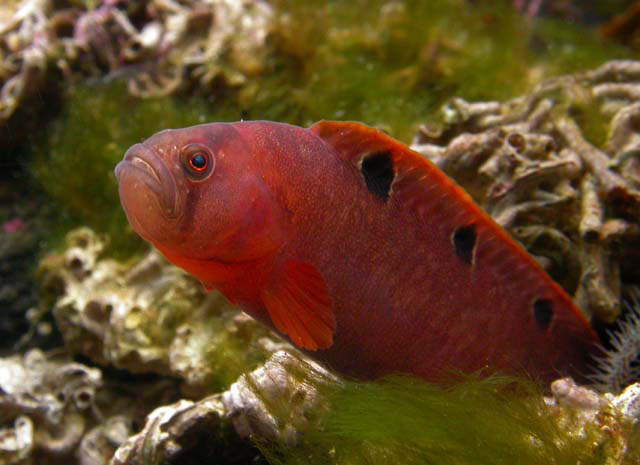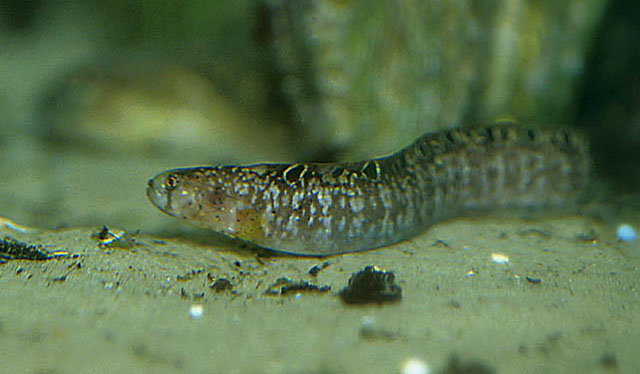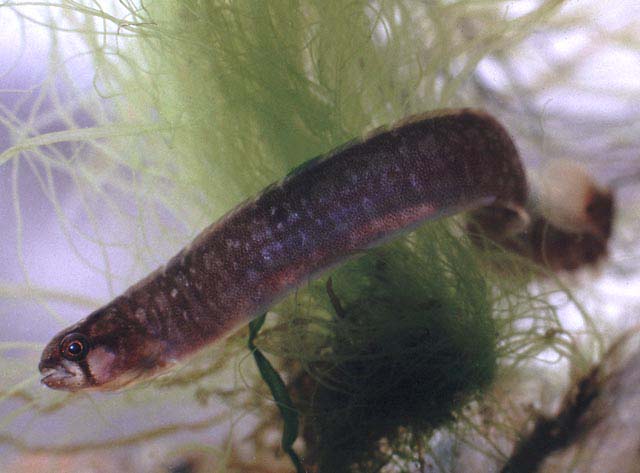Pholis
gunnellus
(Linnaeus,
1758)
Rock gunnel
View all media / Upload your photos and videos
Expand all
Classification / Names
Teleostei (teleosts) > Perciformes/Zoarcoidei (Eelpouts and pricklebacks) >
Pholidae (Gunnels)
> Pholinae
Etymology: Pholis: Greek, pholis, -idos = scale (Ref. 45335).
More on author:
Linnaeus.
Environment / milieu / depth range / climate zone / distribution range
Distribution
North Atlantic: Kanin Peninsula southward to La Rochelle (including White Sea, North Sea and Baltic), also Iceland, but not eastern Greenland, Spitzbergen or Novaya Zemlya. Western Atlantic: Labrador, Canada to Delaware Bay, USA (Ref. 7251).
Maps

Pholis gunnellus / Native range
AquaMaps Data sources:
GBIF
OBIS
This map was computer-generated and has not yet been reviewed.

Pholis gunnellus / Suitable habitat
AquaMaps Data sources:
GBIF
OBIS
This map was computer-generated and has not yet been reviewed.

Pholis gunnellus / Point map
AquaMaps Data sources:
GBIF
OBIS
This map was computer-generated and has not yet been reviewed.

Pholis gunnellus / Year 2050
AquaMaps Data sources:
GBIF
OBIS
This map was computer-generated and has not yet been reviewed.
Size / Weight / Age
Biology
Occurs in shallow waters (seashore, tide pools), but descends (especially in winter) to 100 m or more. May remain out of water under rocks or seaweeds (Ref. 31184). Feeds on small crustaceans, polychaetes, mollusks and fish eggs. The eggs are laid on the sea bed in a large clump, which is closely guarded until hatched (Ref. 9900). Breathes air when out of water (Ref. 31184). Spawning occur in November - January . Female lays 80-200 eggs in a large ball under a stone or in an empty bivalve shell (Ref. 35388).
Life cycle and mating behavior
Male and female coil around the egg ball (Ref. 58332).
Main reference
Makushok, V.M. 1986 Pholididae. p. 1124-1125. In P.J.P. Whitehead, M.-L. Bauchot, J.-C. Hureau, J. Nielsen and E. Tortonese (eds.) Fishes of the North-eastern Atlantic and the Mediterranean. UNESCO, Paris. Vol. 3. (Ref. 4693)
IUCN Red List Status (Ref. 125652)
CITES (Ref. 131153)
Not Evaluated
CMS (Ref. 116361)
Not Evaluated
Threat to humans
Harmless
More information
- Countries
- FAO areas
- Ecosystems
- Occurrences
- Introductions
- Stocks
- Ecology
- Diet
- Food items
- Food consumption
- Ration
- Common names
- Synonyms
- Metabolism
- Predators
- Ecotoxicology
- Reproduction
- Maturity
- Spawning
- Spawning aggregation
- Fecundity
- Eggs
- Egg development
- Age/Size
- Growth
- Length-weight
- Length-length
- Length-frequencies
- Morphometrics
- Morphology
- Larvae
- Larval dynamics
- Recruitment
- Abundance
- References
- Aquaculture
- Aquaculture profile
- Strains
- Genetics
- Allele frequencies
- Heritability
- Diseases
- Processing
- Mass conversion
- Vision
- Pictures
- Stamps, Coins Misc.
- Sounds
- Ciguatera
- Speed
- Swim. type
- Gill area
- Otoliths
- Brains
Estimates based on models
Preferred temperature (Ref. 123201): 4.3 - 11.9, mean 9.5 °C (based on 692 cells).
Phylogenetic diversity index (Ref. 82804): PD50 = 0.5005 [Uniqueness, from 0.5 = low to 2.0 = high].
Bayesian length-weight: a=0.00209 (0.00111 - 0.00393), b=3.17 (3.00 - 3.34), in cm total length, based on LWR estimates for this species & (Sub)family-body (Ref. 93245).
Trophic level (Ref. 69278): 3.5 ±0.5 se; Based on food items.
Resilience (Ref. 120179): Medium, minimum population doubling time 1.4 - 4.4 years (tm=1-3; K=0.18-0.29; tmax=12).
Fishing vulnerability (Ref. 59153): Low to moderate vulnerability (34 of 100).
Nutrients (Ref. 124155): Calcium = 45.4 [22.6, 102.7] mg/100g; Iron = 0.459 [0.178, 0.913] mg/100g; Protein = 17.6 [16.6, 18.6] %; Omega3 = 0.25 [0.12, 0.51] g/100g; Selenium = 11 [4, 27] μg/100g; VitaminA = 14.6 [2.9, 73.2] μg/100g; Zinc = 0.637 [0.420, 0.952] mg/100g (wet weight);




